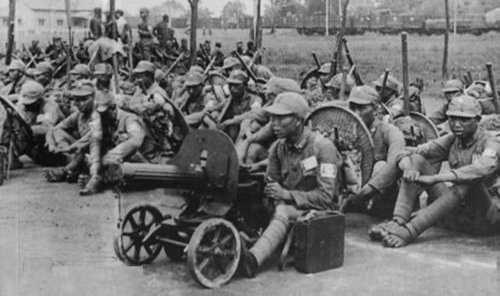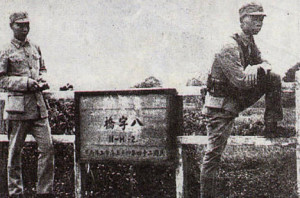The Battle Erupts (I)
- By Peter Harmsen
- 12 August, 2014
- No Comments
 Friday, August 13, 1937 marked the start of the epic, three-month battle of Shanghai, at least according to official Chinese historiography, where the date is so widely accepted that a frequently used alternative name for the entire struggle is “August 13.” Chinese historians have also conventionally agreed on the place where they believed the battle started: At Bazi Bridge, or Eight Character Bridge, spanning a creek in the northern part of the city. For the Chinese, the 60-foot long structure was a natural route of advance into the sector of the city controlled by the Japanese. The book Shanghai 1937: Stalingrad on the Yangtze describes what happened near the bridge on that fateful day:
Friday, August 13, 1937 marked the start of the epic, three-month battle of Shanghai, at least according to official Chinese historiography, where the date is so widely accepted that a frequently used alternative name for the entire struggle is “August 13.” Chinese historians have also conventionally agreed on the place where they believed the battle started: At Bazi Bridge, or Eight Character Bridge, spanning a creek in the northern part of the city. For the Chinese, the 60-foot long structure was a natural route of advance into the sector of the city controlled by the Japanese. The book Shanghai 1937: Stalingrad on the Yangtze describes what happened near the bridge on that fateful day:

Chinese soldiers on Eight Character Bridge
“At about noon, Major Yi Jin, a battalion commander of the 88th Infantry Division, led a couple of hundred men of his battalion from the area around the North Railway Station towards Eight Character Bridge. When the soldiers reached their objective at about 3:00 p.m., they spotted a small Japanese unit, which had just arrived across the creek and was setting up defensive positions. The Chinese opened fire and managed to take possession of the bridge. Undeterred, the Japanese launched a brief artillery bombardment that resulted in several Chinese casualties. Shots rang out near the bridge on and off until 9:00 p.m. when a precarious silence descended over the area.”
Ferocious as the fighting around the bridge was, it was not the only place where Chinese and Japanese faced off on August 13, and also not even where the first shots were fired. The two sides were shooting at each other at least from mid-morning. East of the bridge, six hours earlier, one of the first clashes took place when Japanese marines dressed in civilian clothes walked up to barricades manned by paramilitary Chinese troops. ”They proceeded to provoke the Chinese guards with loud taunts and jeers,” according to Shanghai 1937. “When the Chinese let off a warning shot into the air, the Japanese fired back, aiming to kill. The Chinese responded in kind, and a deadly exchange followed. From that point on, the situation could no longer be reined in.”
Skirmishes continued throughout the day along the entire Japanese defensive perimeter. By late afternoon, two warships anchored in Huangpu River had even entered the fray, sending shells raining down over Chinese positions. But it was all just a prelude. The real horror, showing how 20th-century warfare had become a total affair, spreading death among both soldiers and civilians, came the day after, on Saturday, August 14, also known as “Black Saturday”. (To be continued)



 Copyright © 2025
Copyright © 2025
Leave a Reply